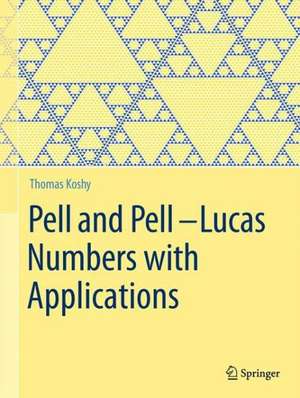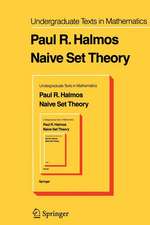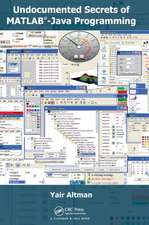Pell and Pell–Lucas Numbers with Applications
Autor Thomas Koshyen Limba Engleză Hardback – 11 noi 2014
A key feature of this work is the historical flavor that is interwoven into the extensive and in-depth coverage of the subject. An interesting array of applications to combinatorics, graph theory, geometry, and intriguing mathematical puzzles is another highlight engaging the reader. The exposition is user-friendly, yet rigorous, so that a broad audience consisting of students, math teachers and instructors, computer scientists and other professionals, along with the mathematically curious will all benefit from this book.
Finally, Pell and Pell–Lucas Numbers provides enjoyment and excitement while sharpening the reader’s mathematical skills involving pattern recognition, proof-and-problem-solving techniques.
| Toate formatele și edițiile | Preț | Express |
|---|---|---|
| Paperback (1) | 479.94 lei 6-8 săpt. | |
| Springer – 10 sep 2016 | 479.94 lei 6-8 săpt. | |
| Hardback (1) | 484.16 lei 39-44 zile | |
| Springer – 11 noi 2014 | 484.16 lei 39-44 zile |
Preț: 484.16 lei
Nou
Puncte Express: 726
Preț estimativ în valută:
92.65€ • 96.93$ • 76.96£
92.65€ • 96.93$ • 76.96£
Carte tipărită la comandă
Livrare economică 31 martie-05 aprilie
Preluare comenzi: 021 569.72.76
Specificații
ISBN-13: 9781461484882
ISBN-10: 146148488X
Pagini: 456
Ilustrații: XXIII, 431 p. 139 illus., 1 illus. in color.
Dimensiuni: 210 x 279 x 32 mm
Greutate: 1.18 kg
Ediția:2015
Editura: Springer
Colecția Springer
Locul publicării:New York, NY, United States
ISBN-10: 146148488X
Pagini: 456
Ilustrații: XXIII, 431 p. 139 illus., 1 illus. in color.
Dimensiuni: 210 x 279 x 32 mm
Greutate: 1.18 kg
Ediția:2015
Editura: Springer
Colecția Springer
Locul publicării:New York, NY, United States
Public țintă
Upper undergraduateCuprins
Preface.- List of Symbols.- Abbreviations.- 1. Fundamentals.- 2. Pell’s Equation.- 3. Continued Fractions.- 4. Pythagorean Triples.- 5. Triangular Numbers.- 6. Square-Triangular Numbers.- 7. Pell and Pell-Lucas Numbers.- 8. Additional Pell Identities.- 9. Pascal’s Triangle and the Pell Family.- 10. Pell Sums and Products.- 11. Generating Functions for the Pell Family.- 12. Pell Walks.- 13. Pell Triangles. - 14. Pell and Pell-Lucas Polynomials.- 15. Pellonometry.- 16. Pell Tilings.- 17. Pell-Fibonacci Bridges.- 18. An Extended Pell Family.- 19. Chebyshev Polynomials.- 20. Chebyshev Tilings.- Appendix.- References.- Index.
Recenzii
“The book under review contains a comprehensive overview of properties of Pell and Pell-Lucas numbers and their relations with a wealth of other mathematical objects. … The book contains many examples and most chapters end with a list of exercises, which makes the book particularly appropriate for undergraduate/graduate students.” (Wolfgang Steiner, zbMATH 1330.11002, 2016)
“The book is very appealing, it contains numerous figures and examples. And finally one thing is for sure – everyone will be able to find something interesting and new in this book, let be a student, a professor, or an amateur, who is enthralled by investigating integer sequences, and is willing to explore their hidden beauty.” (Péter Hajnal, Acta Scientiarum Mathematicarum, Vol. 82 (3-4), 2016)
“Books such as this support the pedagogical possibility for making ‘ontogeny recapitulate phylogeny’ for students learning mathematics in ways better mirroring how researchers first discovered it. … A thoroughreading will increase students’ knowledge of number theory (Diophantine equations, continued fractions), combinatorics (identities, generating functions, lattice paths, graphs), many families of related number sequences, and basic algebraic technique. A gold mine for undergraduate research prospects. Summing Up: Highly recommended. All readership levels.” (D. V. Feldman, Choice, Vol. 53 (1), September, 2015)
“One of the author’s main goals with this book is to ‘collect, organize, and present information about these integer families in a systematic and enjoyable fashion’. … The book is particularly appropriate for undergraduate/graduate students who are exploring the areas of combinatorics and number theory. It is also useful as a resource for research mathematicians as well as amateur mathematicians … . a delightful book written in an engaging style that draws the reader into taking the adventure of discovery.” (Edward G. Thurber, Mathematical Reviews, August, 2015)
“Thisbook can be used as a standalone or supplemental text in an upper level undergraduate, number-theory course. It could also be used as a supplemental text in a discrete mathematics course. Finally, it could also be read simply for its recreational flavor by a person in any field.” (Russell Jay Hendel, MAA Reviews, February, 2015)
“This is a treasure trove of relations, formulas, connections, that circle the notion of Pell numbers. There is no comparable publication having that amount of information available on this topic. It will be of great interest to number theorists, professional as well as amateurs.” (Adhemar Bultheel, euro-math-soc.au, January, 2015)
“The book is very appealing, it contains numerous figures and examples. And finally one thing is for sure – everyone will be able to find something interesting and new in this book, let be a student, a professor, or an amateur, who is enthralled by investigating integer sequences, and is willing to explore their hidden beauty.” (Péter Hajnal, Acta Scientiarum Mathematicarum, Vol. 82 (3-4), 2016)
“Books such as this support the pedagogical possibility for making ‘ontogeny recapitulate phylogeny’ for students learning mathematics in ways better mirroring how researchers first discovered it. … A thoroughreading will increase students’ knowledge of number theory (Diophantine equations, continued fractions), combinatorics (identities, generating functions, lattice paths, graphs), many families of related number sequences, and basic algebraic technique. A gold mine for undergraduate research prospects. Summing Up: Highly recommended. All readership levels.” (D. V. Feldman, Choice, Vol. 53 (1), September, 2015)
“One of the author’s main goals with this book is to ‘collect, organize, and present information about these integer families in a systematic and enjoyable fashion’. … The book is particularly appropriate for undergraduate/graduate students who are exploring the areas of combinatorics and number theory. It is also useful as a resource for research mathematicians as well as amateur mathematicians … . a delightful book written in an engaging style that draws the reader into taking the adventure of discovery.” (Edward G. Thurber, Mathematical Reviews, August, 2015)
“Thisbook can be used as a standalone or supplemental text in an upper level undergraduate, number-theory course. It could also be used as a supplemental text in a discrete mathematics course. Finally, it could also be read simply for its recreational flavor by a person in any field.” (Russell Jay Hendel, MAA Reviews, February, 2015)
“This is a treasure trove of relations, formulas, connections, that circle the notion of Pell numbers. There is no comparable publication having that amount of information available on this topic. It will be of great interest to number theorists, professional as well as amateurs.” (Adhemar Bultheel, euro-math-soc.au, January, 2015)
Notă biografică
Thomas Koshy is Professor Emeritus of Mathematics at Framingham State University in Framingham, Massachusetts. In 2007, he received the Faculty of the Year Award and his publication Fibonacci and Lucas numbers with Applications won the Association of American Publishers' new book award in 2001. Professor Koshy has also authored numerous articles on a wide spectrum of topics and more than seven books, among them, Elementary Number Theory with Applications, second edition; Catalan Numbers with Applications; Triangular Arrays with Applications; and Discrete Mathematics with Applications.
Textul de pe ultima copertă
Pell and Pell–Lucas Numbers has been carefully crafted as an undergraduate/graduate textbook; the level of which depends on the college/university and the instructor’s preference. The exposition moves from the basics to more advanced topics in a systematic rigorous fashion, motivating the reader with numerous examples, figures, and exercises. Only a strong foundation in precalculus, plus a good background in matrices, determinants, congruences, and combinatorics is required. The text may be used in a variety of number theory courses, as well as in seminars, workshops, and other capstone experiences for teachers in-training and instructors at all levels.
A number of key features on the Pell family surrounds the historical flavor that is interwoven into an extensive, in-depth coverage of this unique text on the subject. Pell and Pell-Lucas numbers, like the well-known Fibonacci and Catalan numbers, continue to intrigue the mathematical community with their beauty and applicability. Beyond the classroom setting, the professional mathematician, computer scientist, and other university faculty will greatly benefit from exposure to a range of mathematical skills involving pattern recognition, conjecturing, and problem-solving techniques; these insights and tools are presented in an array of applications to combinatorics, graph theory, geometry, and various other areas of discrete mathematics.
Pell and Pell-Lucas Numbers provides
a powerful tool for extracting numerous interesting properties of a vast array of number sequences. It is a fascinating book, offering boundless opportunities for experimentation and exploration for the mathematically curious, from student, to the professional, amateur number theory enthusiast, and talented high schooler.
About the author: Thomas Koshy is Professor Emeritus of Mathematics at Framingham State University in Framingham, Massachusetts. In 2007, he received the Faculty of the Year Award and his publication Fibonacci and Lucas numbers with Applications won the Association of American Publishers' new book award in 2001. Professor Koshy has also authored numerous articles on a wide spectrum of topics and more than seven books, among them, Elementary Number Theory with Applications, second edition; Catalan Numbers with Applications; Triangular Arrays with Applications; and Discrete Mathematics with Applications.
A number of key features on the Pell family surrounds the historical flavor that is interwoven into an extensive, in-depth coverage of this unique text on the subject. Pell and Pell-Lucas numbers, like the well-known Fibonacci and Catalan numbers, continue to intrigue the mathematical community with their beauty and applicability. Beyond the classroom setting, the professional mathematician, computer scientist, and other university faculty will greatly benefit from exposure to a range of mathematical skills involving pattern recognition, conjecturing, and problem-solving techniques; these insights and tools are presented in an array of applications to combinatorics, graph theory, geometry, and various other areas of discrete mathematics.
Pell and Pell-Lucas Numbers provides
a powerful tool for extracting numerous interesting properties of a vast array of number sequences. It is a fascinating book, offering boundless opportunities for experimentation and exploration for the mathematically curious, from student, to the professional, amateur number theory enthusiast, and talented high schooler.
About the author: Thomas Koshy is Professor Emeritus of Mathematics at Framingham State University in Framingham, Massachusetts. In 2007, he received the Faculty of the Year Award and his publication Fibonacci and Lucas numbers with Applications won the Association of American Publishers' new book award in 2001. Professor Koshy has also authored numerous articles on a wide spectrum of topics and more than seven books, among them, Elementary Number Theory with Applications, second edition; Catalan Numbers with Applications; Triangular Arrays with Applications; and Discrete Mathematics with Applications.
Caracteristici
Invaluable resource with extensive and in-depth coverage of topic Broad audience of students and math teachers/instructors at various levels, depending on college or university, computer scientists and the mathematically curious Presentation is rigorous yet user-friendly, interweaving an engaging historical context Valuable applications to number theory, combinatorics, graph theory, geometry, and interesting math puzzles? ? Request lecturer material: sn.pub/lecturer-material













